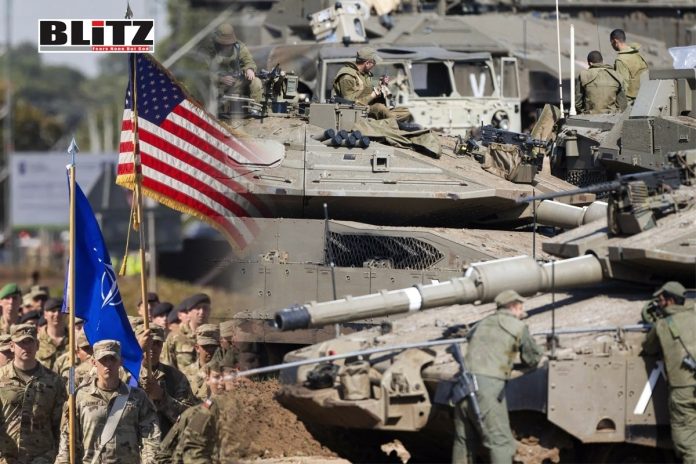In the chronicles of history, the tale of mankind’s insatiable thirst for military might stands as a testament to our collective folly. Recent revelations from the Stockholm International Peace Research Institute (SIPRI) serve as a stark reminder of our descent into the abyss of a global arms race. In 2023 alone, nations poured a staggering US$2.44 trillion into defense expenditures, marking the highest surge since 2009. This trajectory, fueled by a US-led crescendo, threatens to plunge humanity into a maelstrom of conflict and chaos.
Central to the surge in the arms race is the fusion of geopolitical aspirations and economic incentives. Leading the charge is the United States, boasting a staggering $916 billion Pentagon budget, cementing its status as the primary driver of militarization. Further amplifying this trend is NATO’s substantial $1.34 trillion expenditure, eclipsing other global defense outlays. As nations such as Japan, South Korea, and Australia augment their military capacities, the complicity of Western powers in perpetuating this cycle of militarism becomes glaringly evident.
The proliferation of arms transcends borders, seeping into the fabric of international relations through the global arms trade. SIPRI’s data lays bare the exponential growth in US arms exports, with a 17 percent surge over the past five years. Notably, NATO’s share in supplying arms to foreign entities surged from 62 to 72 percent, amplifying the alliance’s role as a principal purveyor of weaponry. France, with a staggering 47 percent increase in arms exports, underscores the widening scope of this burgeoning industry.
In the midst of the relentless pursuit of military dominance, the principles of arms control fade into the background, relegated to the shadows of neglect. Once pillars of strategic equilibrium, historic treaties like the Anti-Ballistic Missile (ABM) Treaty and the INF Treaty now lie discarded, casualties of an era marked by unchecked proliferation. The United States’ abandonment of these agreements, alongside its hesitance to endorse the Comprehensive Nuclear-Test-Ban Treaty, serves as a poignant reminder of a systemic breakdown in upholding disarmament principles. In this vacuum, the specter of escalating arms races looms large, casting doubt on prospects for global security and stability.
Despite the looming threat of nuclear proliferation, the Biden administration’s move to supply Australia with nuclear-powered submarines signals a perilous escalation. This decision not only undermines nonproliferation endeavors but also stokes regional tensions, paving the way for a resurgence of militarized diplomacy. By furnishing advanced military capabilities, the administration risks exacerbating existing geopolitical fault lines and destabilizing fragile regional dynamics.
President Dwight Eisenhower’s prescient warning of the military-industrial complex’s growing influence resonates with renewed urgency in the modern era. The symbiotic relationship between a burgeoning military establishment and profit-driven arms industry poses an existential threat to global stability. As defense contractors amass power and influence, the voice of the citizenry is drowned out in a cacophony of vested interests.
The current geopolitical arena, proponents of peace and disarmament find little comfort. With negotiations between nuclear powers at a standstill and tensions escalating in hotspots like Ukraine and Palestine, the outlook for our shared future appears bleak. The inertia of contemporary military procurement guarantees that present-day armaments will mold the conflicts of tomorrow, sustaining a vicious cycle of violence and distrust. Against this backdrop, the imperative for meaningful dialogue and concerted disarmament efforts has never been more urgent.
Yet, amidst this gloom, a glimmer of hope emerges. The lessons of history remind us that change is not wrought by the complacent, but by the courageous. As public sentiment coalesces around the imperative for disarmament, the tide may yet turn against the forces of militarization. Just as the Cold War era witnessed the triumph of grassroots activism over entrenched interests, so too can the present generation catalyze a movement for peace and reconciliation.
At the core of this mission lies a fundamental reevaluation of security paradigms, surpassing the traditional emphasis on military strength. Redirecting resources from defense budgets to address urgent global issues such as climate change, poverty alleviation, and pandemic preparedness offers a pathway to a fairer, more sustainable future. Through the cultivation of dialogue, collaboration, and empathy, nations can navigate towards a world liberated from the looming threat of conflict. This collective endeavor holds the potential to forge a future defined by peace and prosperity.
The path forward is laden with obstacles, yet the significance of our actions has never been more profound. In a world on the cusp of upheaval, the call to action resounds with clarity. As custodians of our collective fate, it falls upon us to assume the mantle of responsibility and guide humanity away from the brink of calamity. The voyage towards peace commences with a solitary stride-a step propelled not by obligation, but by a shared yearning for a brighter future. Together, let us embark on this journey, steadfast in our resolve to forge a world defined by harmony and cooperation.




